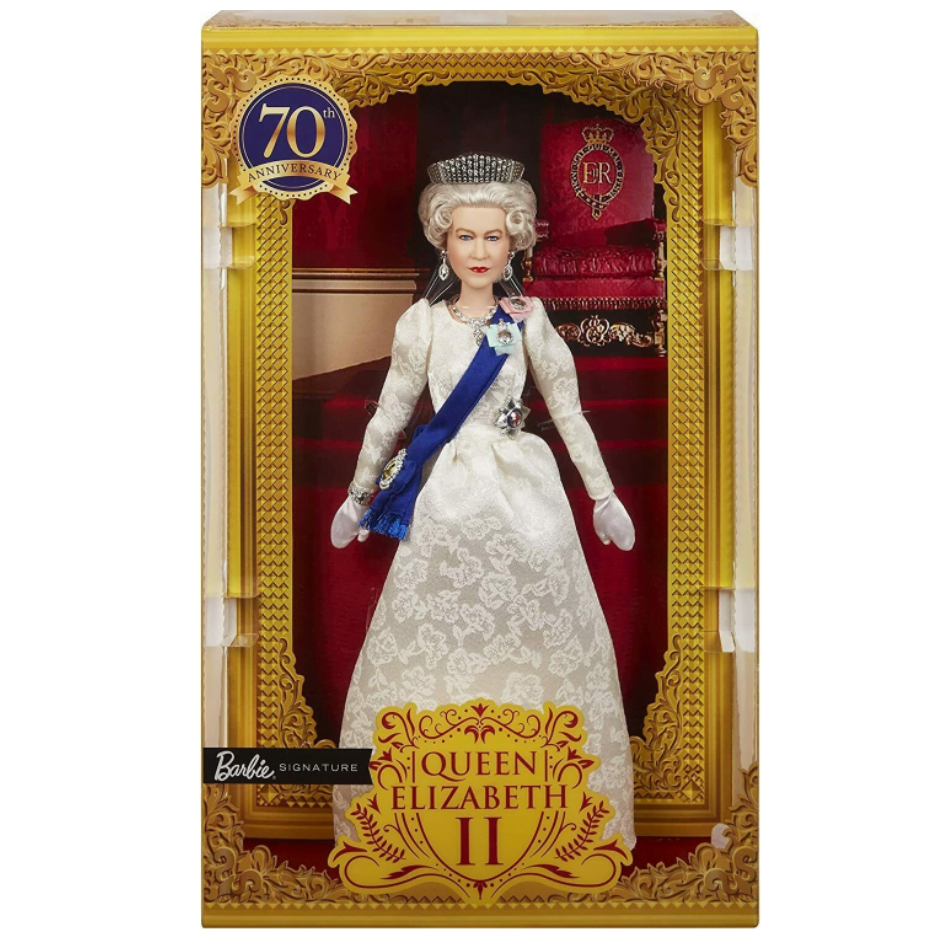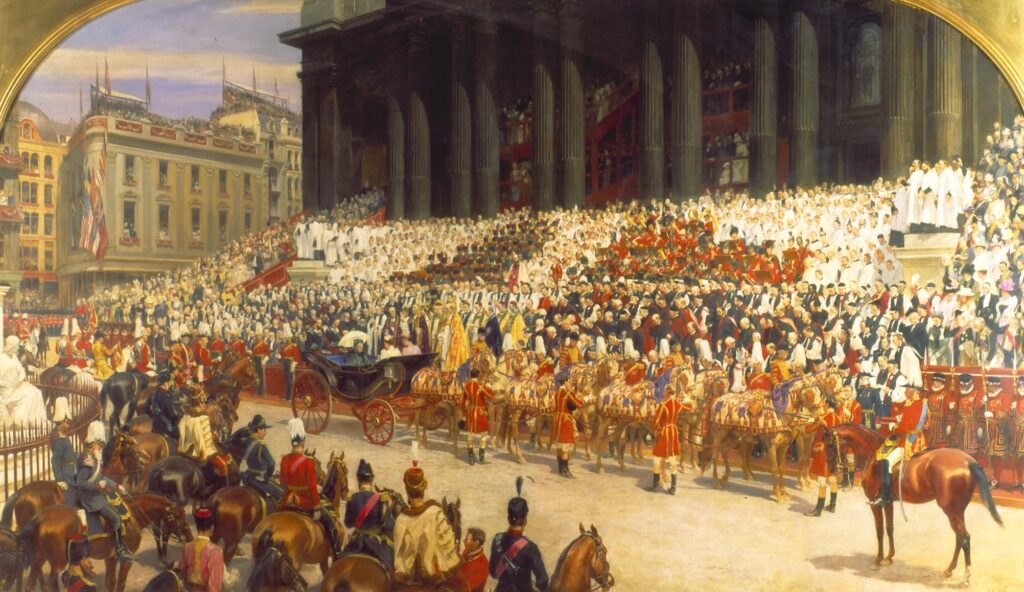Image of a Queen
The Queen has sat for countless formal portraits and photographs, and her image is world-famous. However, most people’s familiarity with her image is rooted in the portrait heads that bedeck British coins, banknotes and stamps. These mundane and indispensable items have been to used create an evocative narrative of the seven decades of her long reign.
The Queen’s successive jubilees have been the pretext for the launch of a plethora of collectible and commemorative items bearing her image, ranging from exquisite bone china tea sets to garish tea towels. The British are currently on a Jubilee shopping spree and the Queen’s image is ubiquitous.
Postage and Money
The Queen’s head has adorned British and Commonwealth money and stamps since her coronation. From British shillings and pence to Canadian cents and Australian dollars, her profile has literally been in the pockets of millions of people. And her face or silhouette has traversed the globe on the stamps of countless letters and parcels.





The history of monarchs’ heads appearing on coins in England goes back to Anglo-Saxon times and the likes of King Offa of Mercia and Alfred the Great. Since the 17th century the sovereign’s head has been shown in profile, and the direction it faces traditionally alternates with each successive reign. The Queen’s head always faces to the right and her successor’s will face the left.
When British coins received a complete facelift with the decimalisation of the currency in 1971, the Queen’s image appeared in a new design by the sculptor Arnold Machin. Updated depictions of her were introduced in 1985, 1998, 2007 and 2012. The coins carry a Latin inscription: ‘Elizabeth II Dei Gratia Regina Fidei Defensor’, which means ‘Elizabeth II, by the grace of God, Queen and Defender of the Faith.’
The Queen’s image can be found on banknotes too – there have been five different depictions of her during her reign. A one pound note, designed by Robert Austin and issued on 17 March 1960, was the first note to carry a portrait of the Queen. On banknotes the Queen’s head always faces left, but with a hidden watermark showing her looking to the right.
The Queen’s head also appears on British stamps – a tradition that started in 1840 when Queen Victoria’s head appeared on the Penny Black. The first image of Queen Elizabeth to appear on the corners of British letters was based on a photograph by Dorothy Wilding. The image lasted from 1952 to 1967, when a new profile created by Arnold Machin and usually set on a single colour, was introduced. The Machin series, as it is known, is still in use, and on its 40th anniversary in 2007, the Post Office issued a stamp featuring a photograph of Machin himself.
Eight stamps have been issued by the Royal Mail to celebrate the Queen’s 70-year reign. They feature photographs from each of the decades of her reign, portraying a hard-working monarch who smiles her way through state visits, walkabouts and Trooping the Colour.
China and Memorabilia
Throughout her reign the Queen has inspired a veritable industry in memorabilia bearing her image. From mugs, plates, spoons and medals to figurines, tins and T-shirts, her face has launched a thousand souvenirs, especially during her jubilee years.
The production of royal souvenirs dates back to the 17th century, but manufacturers were allowed to use the monarch’s image on their products only after the coronation of George II in 1727. Memorabilia of the Queen herself began in earnest in 1953, when many local councils marked her coronation by commissioning potteries to make commemorative mugs to give away to local children. A wide range of items bearing the Queen’s image were mass-produced in the coronation year, ranging from tins of biscuits and tea caddies to handkerchiefs and flags.
In the same year, Wedgwood produced an elegant mug showing the Queen’s profile in blue relief on a white background, while Royal Doulton created a fine bone-china tankard with a photographic portrait of the Queen, semi-framed by an oak branch. This was the last commemorative item to come out of the Doulton factory in Lambeth, London, and has become a valuable collector’s item.
Producers of memorabilia were given another major shot in the arm with the Silver Jubilee in 1977. At the high end of the market, Royal Worcester produced a formal blue plate decorated in the centre by the royal coat of arms in gold on a white background. At the more commercial end, Cadbury’s brought out a handsome Milk Tray chocolates tin, with the portraits of the Queen and Prince Philip appearing on a rich mauve background. Carr’s sold an Assorted Biscuits tin, adorned with a photograph of a smiling Queen sitting on a gold-covered chair.
The Golden Jubilee in 2002 proved no different as a souvenir-spawner, and there was the usual range of goods. Royalists could eat their toast from a classic gold-and-blue Spode plate with a portrait of the Queen, or nibble on Walkers shortbread biscuits from a tin decorated with an image of the Queen superimposed on a gold-coloured map of the world and ringed with flags of the Commonwealth countries. They could pour their Earl Grey from a James Sadler teapot with its gold silhouette of the Queen, and stir in the milk with a Royal Mint silver teaspoon.
To celebrate the Queen’s diamond jubilee in 2012 ardent royalists could buy a tote bag from the National Portrait Gallery, bearing an image of the Queen by Chris Levine, as well as the usual range of mugs, china and biscuit tins bearing the Queen’s image. A solar-powered waving Queen figurine was certainly at the kitsch end of the spectrum. Fortunately Queen Elizabeth is said to have a good sense of humour!


The Platinum Jubilee
Unsurprisingly, 70 years on the throne is being marked with an unprecedented array of merchandise. At the conventional end of the spectrum, mugs, plate and bone china proudly displaying the Queen’s image are a popular choice. Elegant silk scarves, decorated with heraldic devices and national flowers, are a nod to the Queen’s own personal style. Themed biscuit tins and teapots cater to the British love of afternoon tea while paying tribute to the Queen. Picnic hampers and cool bags, decorated with a royal theme, are widely available, and will no doubt be in use at Jubilee picnics. The Queen’s famous corgis have even made their way on to cushions, tea towels and aprons. Sadly, a specially created Queen Barbie doll, released in April 2022, has sold out, and resold Barbies are now the most sought-after Platinum Jubilee memento.






